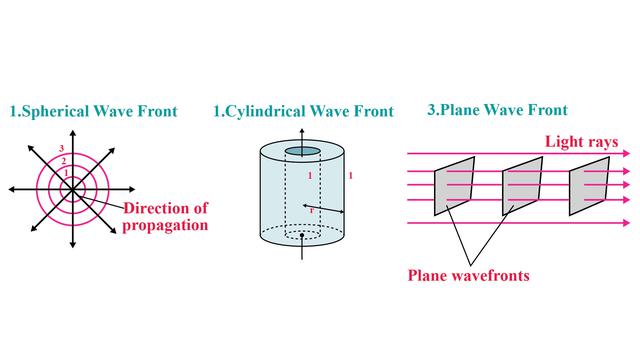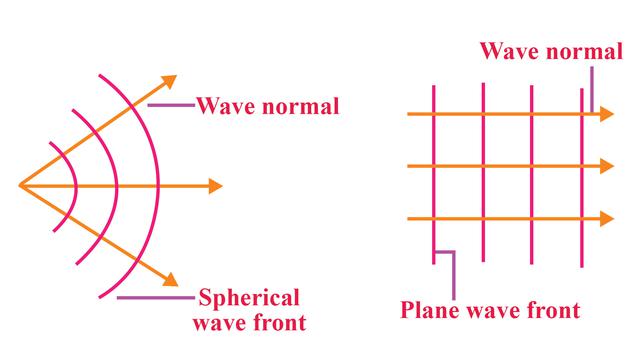A quick revision of all the important concepts
1
Wave Optics
Study of wave nature of light.
Huygens's Principle
Maxwell Electromagnetic Theory According to Maxwell, light is not a mechanical wave. It is an electromagnetic wave which is transverse in nature which travels with a finite speed given by;
Wavefront: A wavefront is defined as the laws of all points of the medium which vibrate in the same phase. Depending on the shape of the source of light, wavefronts can be of three types.
Study of wave nature of light.
Huygens's Principle
- Every point on a wavefront vibrates in same phase with same frequency.
- Every point on a wavefront acts like a new independent source and sends at a spherical wave, called a secondary wave.
- Wave fronts move in space with the velocity of wave in that medium.
Maxwell Electromagnetic Theory According to Maxwell, light is not a mechanical wave. It is an electromagnetic wave which is transverse in nature which travels with a finite speed given by;
Wavefront: A wavefront is defined as the laws of all points of the medium which vibrate in the same phase. Depending on the shape of the source of light, wavefronts can be of three types.

Wave Normal: A perpendicular drawn to the surface of a wavefront at any point, in the direction of propagation of light, is called "wave normal". The direction in which light travels is called a 'ray' of light. Thus, a wave normal is the same as a ray of light.

Types of wavefront

Interference of Light: It is an effect of non-uniform energy distribution in the medium as a result of two light waves being superimposed.
Coherent Sources: Two sources that emit a monochromatic light continuously with a zero (or) constant phase difference between them are called coherent sources.
Incoherent Source: The sources which do not emit light with constant phase difference are called incoherent sources.
Interference of waves of intensity and :
Resultant intensity, where, .
INTERFERENCE: YOUNG'S DOUBLE SLIT EXPERIMENT
Fringe Width: It is defined as the distance between two successive maxima or minima.
Optical path:
In YDSE, usually the intensities and are equal i.e.,
Then or
For maxima:
For minima:
YDSE WITH OBLIQUE INCIDENCE
In YDSE, ray is incident on the slit at an inclination of to the axis of symmetry of the experimental set-up
We obtain central maxima at a point where, or . This corresponds to the point O' in the diagram. Hence, we have path difference.
Coherent Sources: Two sources that emit a monochromatic light continuously with a zero (or) constant phase difference between them are called coherent sources.
Incoherent Source: The sources which do not emit light with constant phase difference are called incoherent sources.
Interference of waves of intensity and :
Resultant intensity, where, .
- For Constructive Interference:
- For Destructive interference:
- If sources are incoherent: , at each point.
INTERFERENCE: YOUNG'S DOUBLE SLIT EXPERIMENT
Fringe Width: It is defined as the distance between two successive maxima or minima.
Optical path:
- Optical path length (because)
- Phase Difference = (optical path difference)
In YDSE, usually the intensities and are equal i.e.,
Then or
For maxima:
For minima:
YDSE WITH OBLIQUE INCIDENCE
In YDSE, ray is incident on the slit at an inclination of to the axis of symmetry of the experimental set-up
We obtain central maxima at a point where, or . This corresponds to the point O' in the diagram. Hence, we have path difference.

Diffraction: When light passes through an opening of size comparable to its wavelength it no longer propagates in straight path but spreads out through the opening. This spreading action of waves is called diffraction.
When the double slit in YDSE is replaced by a single narrow slit, a broad pattern with a central bright region is observed. On both sides, there are alternate dark and bright regions, the intensity becoming weaker away from the centre.
The angular position () of nth diffraction minima is given by
where, n = 1, 2, 3,.....
The mathematical expression for intensity distribution on the screen is given by
where
Diffraction Grating: A diffraction grating defines an optical component with a periodic structure that splits the light into various beams that travel in different directions. It is an alternative way to observe spectra other than a prism. Generally, when light is incident on the grating, the split light will have maxima at an angle .The formula for diffraction grating is used to calculate the angle.
Diffraction grating formula: where,
When the double slit in YDSE is replaced by a single narrow slit, a broad pattern with a central bright region is observed. On both sides, there are alternate dark and bright regions, the intensity becoming weaker away from the centre.
The angular position () of nth diffraction minima is given by
where, n = 1, 2, 3,.....
The mathematical expression for intensity distribution on the screen is given by
where
Diffraction Grating: A diffraction grating defines an optical component with a periodic structure that splits the light into various beams that travel in different directions. It is an alternative way to observe spectra other than a prism. Generally, when light is incident on the grating, the split light will have maxima at an angle .The formula for diffraction grating is used to calculate the angle.
Diffraction grating formula: where,
- is the order of grating,
- is the distance between two fringes or spectra
- is the wavelength of light
- is the angle to maxima


Rayleigh criterion
The Rayleigh criterion is the generally accepted criterion for the minimum resolvable detail - the imaging process is said to be diffraction-limited when the first diffraction minimum of the image of one source point coincides with the maximum of another.
The first minimum is at an angle of , so that two point objects are just resolvable if they are separated by the angle
POLARISATION: An unpolarised light is symmetrical about its direction of propagation. The phenomenon of restricting the oscillation to a particular plane is called polarisation. If a wave has oscillations in all possible directions it is called unpolarised light. If oscillations of light wave are restricted only to a single direction in a plane perpendicular to the direction of propagation it is called as plane of polarized light.
Polarised light can be produced by: (i) refraction (ii) reflection (iii) dichroism (Nicol prism) or by scattering.
Brewster's Law: Brewster's law is a relationship of light waves at the maximum polarization angle of light.
(where is known as Brewster's angle)
(reflected and refracted rays are mutually perpendicular.)
Law of Malus: When polarised light is passed through an analyser its intensity depends upon the angle () between plane of transmission of polariser and analyser and is given by Malus Law i.e.
or
Polaroids: These are devices used for producing strong beam of plane polarised light. These are not natural crystals rather are artificially made polarizing material and consist of thin sheets of plastics with a thin layer of tiny crystal of quiminerodosulphate between them
Resolving power:
The resolving power of an optical instrument, e.g., a telescope or microscope, is a measure of its ability to produce detectably separate images of objects that are dose together.
The smallest or angular separation between two-point objects which appear just resolved when viewed through an optical instrument is called the limit of resolution of the instrument and its reciprocal is called the resolving power of the instruments.
where,
The Rayleigh criterion is the generally accepted criterion for the minimum resolvable detail - the imaging process is said to be diffraction-limited when the first diffraction minimum of the image of one source point coincides with the maximum of another.
The first minimum is at an angle of , so that two point objects are just resolvable if they are separated by the angle
POLARISATION: An unpolarised light is symmetrical about its direction of propagation. The phenomenon of restricting the oscillation to a particular plane is called polarisation. If a wave has oscillations in all possible directions it is called unpolarised light. If oscillations of light wave are restricted only to a single direction in a plane perpendicular to the direction of propagation it is called as plane of polarized light.
Polarised light can be produced by: (i) refraction (ii) reflection (iii) dichroism (Nicol prism) or by scattering.
Brewster's Law: Brewster's law is a relationship of light waves at the maximum polarization angle of light.
(where is known as Brewster's angle)
(reflected and refracted rays are mutually perpendicular.)
Law of Malus: When polarised light is passed through an analyser its intensity depends upon the angle () between plane of transmission of polariser and analyser and is given by Malus Law i.e.
or
Polaroids: These are devices used for producing strong beam of plane polarised light. These are not natural crystals rather are artificially made polarizing material and consist of thin sheets of plastics with a thin layer of tiny crystal of quiminerodosulphate between them
Resolving power:
The resolving power of an optical instrument, e.g., a telescope or microscope, is a measure of its ability to produce detectably separate images of objects that are dose together.
The smallest or angular separation between two-point objects which appear just resolved when viewed through an optical instrument is called the limit of resolution of the instrument and its reciprocal is called the resolving power of the instruments.
where,


